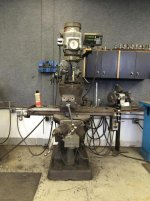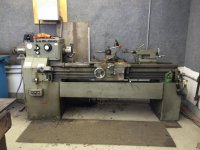Support for Layout and Precision Measuring
Some Interesting statistics : This thread was started Sept 18, 2014 (11 days). It has consistently stayed in the top 10 threads, more often than not - in the top 5, and more than it's share in the #1 position. It has had 3,885 views, 73 replies, and 116 likes. I think these numbers are impressive, and am nearly overwhelmed by the good response in interest on this topic.
I have had a large number of requests - including those private - to continue the thread. The positive responses are outnumbering the negative by better than 4 to 1. I count negatives as 1 vote if they are from the same person; no matter how often that critic posts.
In view of all this, I am going to try if at all possible to continue. Keeping ever in my mind, the small 1 man start-up general job shop - on a frugal budget - but hoping
some of this may be useful to all. For the man with deep pockets, I doubt that he would find much of interest here. Above all, I am well aware that probably every reader might have a better way to do something. Please, please jump in with your suggestion. It will be better for everybody.
If all goes well, I hope soon to add a table of contents to the first post. This should be of help to see what all is included in our thread, and go quickly to that post.
Starting the small job shop, I think it is normal to quickly get into repair jobs. There are a lot of fabrication jobs out there, but I don't think it is fair to the customer to do experimental techniques on his work. Better to get your technique down good on your own projects first. Also, it is fairly easy to bid on small-lot vendor jobs; but keep in mind, a 200 piece job probably looks attractive to some CNC people. So, I'm keeping in mind the less than a dozen lot jobs. It may come as a surprise to the start up, to quickly find out that many of the repair jobs really have tight tolerances. This is what will determine reputation, and ultimately success; how well a person can identify the precise tolerance needed and deliver that. So, with all this said, I'll attempt to pass on some tips for an infrastructure that should be helpful in achieving a quality performance.
Much of the following may seem elementary, but if you please bear with me it will all come together.
WORK BENCHES : One of the beautiful things about a small start-up shop, is that it is possible to design benches custom made to your unique body. Why should a tall man have to bend over and work in pain? A short man on his toes? When your shop grows and you order new benches, you can let your apprentice kids use yours. They will really like it when you sit down and work with them. A good motivator. I like 4X4 wood legs on a wood bench, but if you have run into a scrap-pile of angle iron, that may be your way to go. When my son and I started up about 15 years ago, unbelievable; a large corporation
gave him 6 pickup loads of new lumber that they wanted out of their way. 2X4s, 4X4s, plywood etc. We went with 2 L 2X4 legs because we didn't have a saw big enough to make 1 cut through the 4X4s. 2 layers of plywood with of course the good side up. Then we found some special kitchen "counter-top" adhesive sheets at the home-improvement on discount. This was one of the luckiest things I've stumbled into. Those "counter-top" sheets worked better than our wildest dreams. We did a quick power-sand on the plywood before we laid the tough plastic on. Total cost with a box of wood screw-bolts used on 3 benches and some left over, and special top - I think under $20 a piece. The bench with a vice has withstood numerous sledge-hammer work through the years; we like to make our own custom brackets etc., with the rose-bud and hammer. That bench is still solid.
We also made about 6 roll-around cabinets on roller castors. ~3' wide X 20"? deep ~6' tall. Each cabinet is for a special purpose - shop supplies, electrical, mechanic tools, hand power tools etc. Since our work was machine rebuild, it was really handy to wheel a couple of cabinets right to the job even in our small shop of 1000 sq ft. With a trouble light hung on the cabinet and a "clamp-on" light for the work. They are painted and stencil labeled, and I think look as good as most shops or better. It sure is a handy way to work..
PRELIMINARY LAY OUT BENCH : This is the bench that should be used to lay out parts before machining, for reference only. For example, the V-block job that I put in the first post. Were I to start that job tomorrow, after I had cut that part out with the torch and dressed up the faces and then milled the faces and blued, I would put such work on the preliminary bench and take a paper template for reference and with the plate sitting flat on the table, slide the template around the top of the plate finding the best compromise for clean-up machining, and mark out the corner dimensions on the plate. This saves a some-times disaster, and always gives you peace of mind while you're working. And above all, only takes a moment. The above design of the bench with the special top material is ideal, and as a great surprise to us, has took terrible abuse and still shows no dents or cuts. On top of that, it is super easy to clean making it look new. Somehow the material absorbs sharp edges and springs back. I've long ago forgotten the name but maybe I could find out. Not thinking far enough ahead, we probably should have made ours square instead of rectangular. I don't think it is desirable to use precision layout instruments at this stage; for myself I use carpenter's squares, 24" flex thin steel rule, and a builder's 48"? rule; because you are working with slag on the sides of the parts, and nothing has to be that precise for just a reference.
PRECISION LAY OUT PLATE : The one I enjoyed using the most was an antique 6' sq cast-iron with reinforcement ribs on the bottom. But woe to me if someone were to get on it not knowing what they were doing. I really don't see much choice on this but a granite plate. At this point maybe it would be good to stop and think what our objective is.. It most probably is to check .001, more rarely .0005 and the occasional .0001. A 3 millionths plate is not necessary for these type of measurements. For smaller work, a harbor-freight job should do just fine. For larger, I would suggest an auction where a grungey plate is cocked on it's side against an old rusty part. They'll probably pay you to haul it off. If you had it inspected, and the inspector told you it had a 20 millionths twist - highly unlikely - that means in the small area you would normally be working in; you might be off 5 or 10 millionths.. ??? Before you take it, look it over carefully for metal flakes imbedded in the surface; if need be with a bright flashlight at an angle. They need to come out before you use it; and this is a tedious care job of much work with even just a handful of flakes. Aluminum is especially bad about it. If while taking them out, you left a microscopic hole, that should have about a zero effect on the quality of
your work. Of course, a big corporation does not want to do this.. Then, when I brought it home, I.... would go through the granite plate maintenance literature and start to work. If it had a chip on one side, make that side the rear side etc. I have built several resting tables for large granite plates in my time. Angle iron frame with ~3/8" clearance on all sides; a 3/4" plywood bed, and 4 heavy tubing legs. Pads on the bottom if your floor is in good smooth shape, without if on a kinda rough surface floor. I do not believe the sales pitch saying a 3 point support is the way to go. An easy way to lower your plate into the angle plate bed, is to stack up pallets to just under the table, and the top pallet with sturdy blocks extending through the gaps in your bed frame, lay the plate with plywood positioned correctly underneath the plate to the frame, on your safe supporting non-movable blocks, then raise the top pallet up with the fork truck just enough to pull out some pallets from the stack, then lower the plate into the bed with the fork-truck in the top pallet. Just lower gently. I don't like to hurry in these types of situations, but a half-hour to install the plate in it's bed seems to be excessive...
For large work it is necessary to improvise; and I one time did ~200 main rib wing-spars ~40' long from aluminum extrusion for as subcontractor with another shop for C 130 aircraft rebuilds. I used carpenter saw-horses for the final lay-out before machining with a Bridgeport and much work on each spar. With Govt inspection, my work had total acceptance. With big fabrications, I usually laid out on the machine.




 kicked in on me and justice overruled your embarassment, other's jealousy, and my credibility
kicked in on me and justice overruled your embarassment, other's jealousy, and my credibility 





 Hoping others would join in
Hoping others would join in